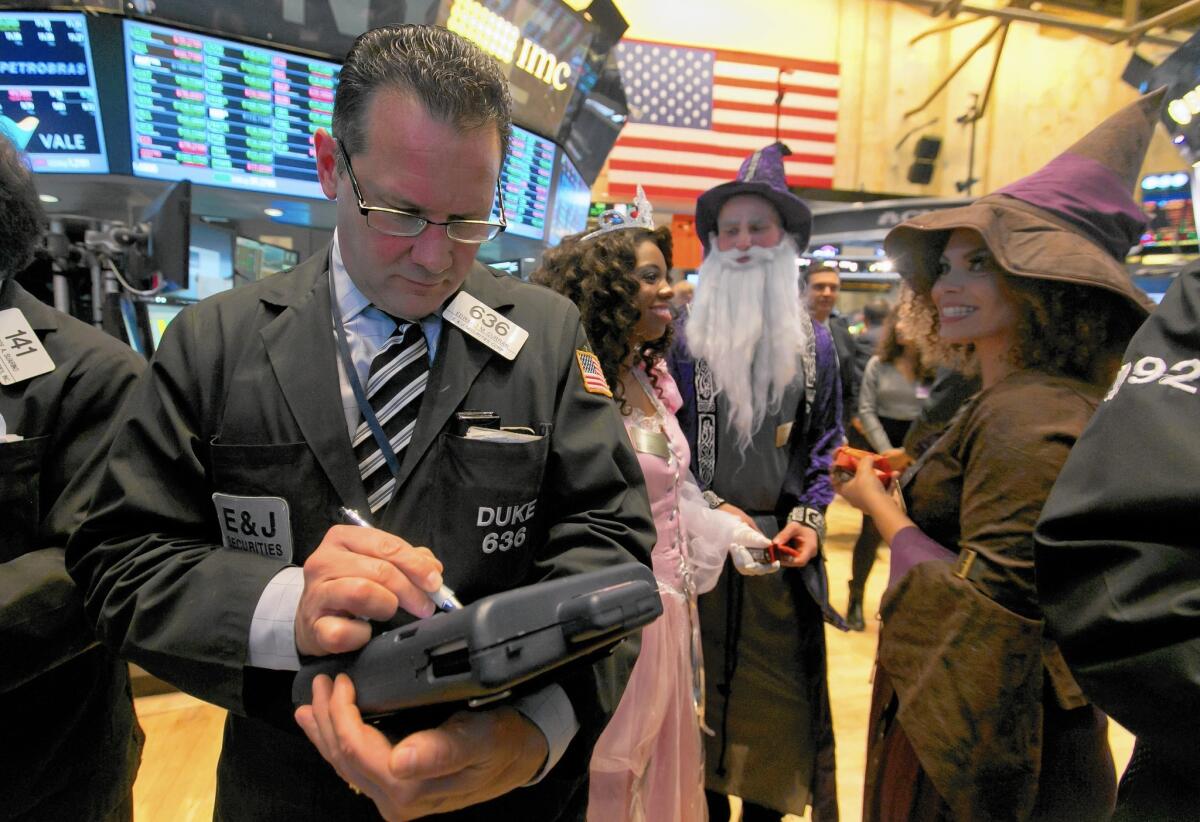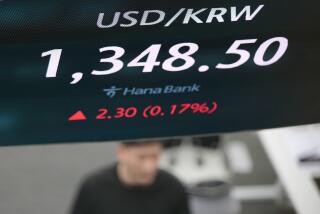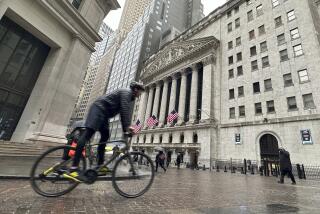Dow flirts with record high as Japan gives stock markets a boost

Investors who have been waiting for good news on the global economy finally got some Friday.
Sparked by a surprisingly assertive policy move from the Bank of Japan, U.S. stocks joined a worldwide rally to close out a wild October with what analysts see as positive momentum.
Japan said it would ramp up its bond-buying stimulus, and its massive public pension fund said it would make a big shift in investments to reduce its domestic bond holdings and to acquire more stocks, including foreign equities.
The one-two punch lifted hopes that Japan, the world’s third-largest economy, could get back on track in its long-running efforts to revive economic growth and escape from deflation.
“It’s important for the world economic outlook in general,” said Chris Rupkey, chief financial economist at the Bank of Tokyo-Mitsubishi. Investors have been worried about the fragile Eurozone recovery and slowdowns in China and other large emerging economies. “Everything seemed to be running off the rails in the mind of the markets.”
Moreover, the move by the Japanese central bank came only two days after the U.S. Federal Reserve brought a close to its bond-buying stimulus, thus providing a nervous market with a surprising replacement for a program that had been seen as helping prop up the world economy and the markets.
“Just as the Fed is ending its program, all of a sudden another sugar daddy shows up in the form of the Japanese central bank,” said Bob Johnson, director of economic analysis for Morningstar.
The Dow Jones industrial average hit a record high during trading Friday before settling with a gain of 195.10 points, or 1.1%, to 17,390.52, ending October on a positive note.
That marked a dramatic about-face after a near-10% drop over several nail-biting days in the middle of the month, fueling concerns that the market was weakening. The broader Standard & Poor’s 500 index rose 23.40, or 1.2%, to a near-record 2,018.05.
Traders’ screens flashed green across the board as stock markets in Europe, Latin America and Asia hit positive territory. Germany’s DAX index rose 3%, the main Argentine and Brazilian indexes both gained more than 4% and Japan’s Nikkei index led the way with a 4.8% gain.
October is a notoriously volatile month for stock markets historically. The biggest panics in U.S. history — 1929 and 1987 — came in October, and some of the biggest drops during the 2008 crisis also came in October.
The jolt from the Bank of Japan, approved in a 5-4 vote by its board, would expand the bond-buying to the equivalent of about $720 billion annually. That increased pace, about 60% higher than current levels, is close to the pace of the Fed’s own program, which consisted of three rounds of bond-buying over the last six years.
The Fed’s last round, buying $85 billion a month in Treasury bonds and mortgage-backed securities, was gradually wound down over the last year and ended this week. The three rounds left the Treasury with about $4 trillion in assets.
Some analysts doubt that Japan’s new injection of liquidity will make a big difference in the long run because it doesn’t address fundamental weaknesses in the economy. But it caught the world by surprise.
“Here’s an economy that’s been in the doldrums for years, but the market didn’t expect such a massive stimulus,” said Alan Whitman of Morgan Stanley.
The Japanese move comes as the U.S. economy has become the primary engine for global growth.
On Thursday, the government reported that U.S. gross domestic product, the total value of the goods and services produced, increased at a 3.5% annual rate in the third quarter. That came after a second-quarter bounce of 4.6%, mainly recovering from a brutal winter that brought a 2.1% contraction at the start of the year.
Indeed, the Fed’s announcement of its end to massive bond purchases was an explicit affirmation of its belief that the economy’s recovery had gained momentum. The Fed in particular cited “solid” job gains in recent months and the drop in the jobless rate, which fell to 5.9% in September.
Economic data reports also have buoyed investors.
A closely watched index of consumer sentiment rose to its highest level since 2007 as consumers expressed positive views both about the outlook for the economy and for their own personal financial prospects. That confidence level comes on top of falling gas prices, which is putting more money in consumers’ pockets, and upticks in personal savings rates.
Still, the market has a notoriously short memory, and some of the problems that spooked the market in the middle of the month haven’t gone away. Chief among them is Europe, which is struggling to stay out of a recession and where a Japanese-style stimulus is much harder to pull off for political and structural reasons.
And the U.S. has its own structural economic problems that could weigh on the market. John Lonski, an analyst at research firm Moody’s Analytics, noted that the recovery has been concentrated in the corporate sector and at mostly upper income levels.
“The reality is, the improvement in the economy owes much to a disproportionate amount going to upper incomes and those with above-average wealth,” he said, and the “shrinkage of the middle class” could dampen the prospects for the economy and the markets over the longer term.
Another concern: The dollar hit a four-year high in the wake of Japan’s announcement — and the yen fell to more than 112 on the dollar. The stronger greenback, though, could hurt U.S. exports and fuel complaints from U.S. manufacturers.
Still, the Japanese central bank’s bold moves break what had been a persistently gloomy narrative of overseas economic news, providing support for investors looking to buy on the positive U.S. economic news.
And volatility, as measured by the VIX index, Wall Street’s so-called “fear index,” is down to moderate levels after cresting in mid-October at the highest levels in three years.
The Dow closed the month with a modest 0.89% gain.
Starkman reported from New York; Lee from Washington.








